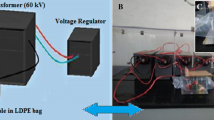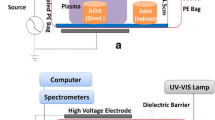Abstract
There are currently limitations to storing and feeding distillers wet grains (DWG) due to their potential for spoilage and mycotoxin contamination in storage. In this study, in-package treatments of DWG using high-voltage atmospheric cold plasma (HVACP) treatment and storage in modified atmosphere with carbon dioxide were investigated with the primary purpose of increasing product shelf-life. The conditions investigated were (1) HVACP treatment and modified atmosphere packaging (MAP) storage, (2) carbon dioxide-modified atmosphere storage, and (3) HVACP treatment and carbon dioxide-modified atmosphere storage, compared with a control sample with no treatment under MAP storage. Treated samples and controls were stored for 0, 7, 14, 21, and 28 days at 10 and 25 °C, after which treated samples were evaluated for their efficacy to control mold growth indicated by pH, microbial count (CFU/g)/log reduction, and peroxide (H2O2) level. There was a significant difference among the treatments indicated by CFU/g (P < 0.003) and pH (P < 0.0001). The HVACP treatment alone and its combination with carbon dioxide-modified atmosphere storage provided a better control of microbial growth and preservation in the wet substrate (>60% moisture), DWG for up to 28 days of storage at 10 and 25 °C. Both HVACP and the combination treatment showed high peroxide levels (100 mg/L) after treatment, which degraded in storage over time. It is thought that a better strategy for the combination treatment would be to treat substrate using HVACP with MAP having a high O2 concentration (65%) and store samples post-treatment in-package in a high CO2 environment.


Similar content being viewed by others
References
Beuchat, L., Chmielewski, R., Keswani, J., Law, S. E., & Frank, J. F. (1999). Inactivation of aflatoxigenic Aspergilli by treatment with ozone. Letters in Applied Microbiology, 29, 202–205.
Chen, Y. (2014). High voltage atmospheric cold plasma treatment of refrigerated chicken eggs for control of salmonella enteritidis on external surface. MS Thesis, Purdue University, 2014, Dissertations & Theses @ CIC Institutions, ProQuest.
Christensen, C. M., & Kalscheur, K. F. (1974). Storage of cereal grains and their products. American Association of Cereal Chemists Microflora, 158–192.
Christensen, D. L., Rolfe, K. M., Klopfenstein, T. J., & Erickson, G. E. (2010). Evaluation of storage of covers when wet distillers byproducts are mixed and stored with forages. Nebraska Beef Rep, MP93, 21.
Deng, S., Ruan, R., Mok, C. K., Huang, G., Lin, X., & Chen, P. (2007). Inactivation of Escherichia coli on almonds using nonthermal plasma. Journal of Food Science, 72(2), 62–66.
Dobrynin, D., Wasko, K., Friedman, G., Fridman, A., & Fridman, G. (2011). Cold plasma steriliza of open wounds: live rat model. J Plasma Med, 1(2), 109–114.
Eto, H., Ono, Y., Ogino, A., & Nagatsu, M. (2008). Low temperature internal sterilization of medical plastic tubes using a linear dielectric barrier discharge. Plasma Processes and Polymers, 5(3), 269–274.
Fernandez, A., Shearer, N., Wilson, D. R., & Thompson, A. (2012). Effect of microbial loading on the efficiency of cold atmospheric gas plasma inactivation of Salmonella enterica serovar Typhimurium. International Journal of Food Microbiology, 152(3), 175–180.
Gordillo-Vazquez, F. J. (2008). Air plasma kinetics under the influence of sprites. Journal of Physics D: Applied Physics, 41, 234016.
Grabowski, L. R., Van Veldhuizen, E. M., Pemen, A. J. M., & Rutgers, W. R. (2007). Breakdown of methylene blue and methyl orange by pulsed corona discharge. Plasma Sources Science Technology, 16, 226–232.
Han, L., Patil, S., Keener, K. M., Cullen, P. J., & Bourke, P. (2014). Bacterial inactivation by high voltage atmospheric cold plasma: influence of process parameters and effects on cell leakage and DNA. Journal of Applied Microbiology, 116(4), 784–794. doi:10.1111/jam.12426.
Harding, J.L. (2012). Spoilage of wet distillers grains plus solubles when stored in a bunker. MS. Thesis, University of Nebraska, Theses and Dissertation. http://ag.udel.edu/anfs/faculty/kung/documents/05AerobicStability.pdf.
IFST (1993). Shelf-life of foods—guidelines for its determination and prediction. Institute of Food Science and Technology, London. ISBN 0 905367 11 1.
Jay, J. M., Loessner, M. J., & Golden, D. A. (2005). Modern food microbiology (7th ed.). New York, NY: Springer.
Joshi, S. G., Cooper, M., Yost, A., Paff, M., Ercan, U. K., Fridman, G., Friedman, G., Fridman, A., & Brooks, A. D. (2011). Nonthermal dielectric-barrier discharge plasma-induced inactivation involves oxidative DNA damage and membrane lipid peroxidation in Escherichia coli. Antimicrobial Agents Chemotherapy., 55(3), 1053–1062.
Keener, K. M., & Klockow, P. A. (2010). Non-equilibrium plasma generation in a sealed package. U.S. patent no. U.S. patent application 64796. Washington, D.C: U.S. Patent and Trademark Office.
Kingsly, A. R. P., Ileleji, K. E., Clementson, C. L., Garcia, A., Maier, D. E., Stroshine, R. L., & Radcliff, S. (2010). The effect of process variables during drying on the physical and chemical characteristics of corn dried distillers grains with solubles (DDGS)—plant scale experiments. Bioresource Technology, 101, 193–199.
Klockow, P. A., & Keener, K. M. (2009). Safety and quality assessment of packaged spinach treated with a novel ozone-generation system. LWT - Food Science and Technology, 42, 1047–1053.
Klopfenstein, T. J., Erickson, G. E., & Bremer, V. R. (2007). Feeding corn milling byproducts to feedlot cattle. Veterinary Clinics of North America: Food Animal Practice, 23, 223–245.
Kung, L. (2010) Aerobic stability of silages. Proceedings of the Conference on Silage for Dairy Farms. Retrieved from http://alfalfa.ucdavis.edu/+symposium/proceedings/2010/10-89.pdf
Lehman, R. M., & Rosentrater, K. A. (2012). Aerobic stability of distillers wet grains as influenced by temperature. Journal of Science Food Agriculture, 93, 498–503.
Linley, E., Denyer, S. P., McDonnell, G., Simons, C., & Maillard, J.-Y. (2012). Use of hydrogen peroxide as a biocide: new consideration of its mechanisms of biocidal action. Journal of Antimicrobial Chemotherapy, 67(7), 1589–1596.
Liu, S. and K. A. Rosentrater. 2012. Chemical composition of DDGS. In: Distillers grains—production, properties and utilization. CRC Press, Copyright by Taylor and Francis Group LLC.
Lu, H., Patil, S., Keener, K. M., Cullen, P. J., & Bourke, P. (2013). Bacterial inactivation by high-voltage atmospheric cold plasma: influence of process parameters and effects on cell leakage and DNA. Journal of Applied Microbiology, 116, 784–794.
McClurkin, J. D. (2009). Control of stored grain fungi and off odors with ozone in a grain treatment system. MS Thesis Purdue University, 2009. Dissertations & Theses @ CIC Institutions, ProQuest.
McClurkin-Moore, J.D. (2015). Shelf-life improvement of distillers wet grains with solubles. PhD Diss. Purdue University, 2015. Dissertations & Thes]ProQuest.
McClurkin, J.D. and K.E. Ileleji. (2015). The effect of storage temperature and percentage of condensed distillers solubles on the shelf-life of distillers wet grains stored aerobically. Journal of Stored Product Research, 62(2015), 58–64.
Müller, S., & Zahn, R. J. (2007). Air pollution control by non-thermal plasma. Contributions to Plasma Physics, 47(7), 520–529.
Nofsinger, G. W., VanCauwenberge, J. E., Bothast, R. J., & Kwolek, W. F. (1983). An evaluation of chemical methods to extend the allowable storage time of wet distillers’ grains. J. Agric. Food Chemisty, 31, 276–279.
Pardo, G., & Zufia, J. (2012). Life cycle assessment of food-preservation technologies. Journal of Cleaner Production., 28, 198–207.
Prusky, D., & Yakoby, N. (2003). Pathogenic fungi: leading or led by ambient pH? Molecular Plant Pathology, 4(6), 509–516.
Rosentrater, K., & Lehman, R. (2010). Predicting stability of distillers wet grains (DWG) with color analysis. Food and Bioprocess Technology, 3(2), 204–212.
Sensenig, R., Kalghatgi, S., Fridman, G., Shereshevsky, A. Brooks, A., Vailets, V., Gutsol, A., Fridman, A., & Friedman, G. (2008). Induction of apoptosis in melanoma cells by non-thermal atmospheric plasma discharge. SSO’s 61st Annual Cancer Symposium, Chicago, USA. March 13–16.
Shreve, B., Thiex, N., & Wolf, M. (2006). National forage testing association reference method, dry matter by oven drying for 3 hr at 105 C. NFTA reference methods. Omaha, NB: National Forage Testing Association URL:www.foragetesting.org.
Spiehs, M. J., Whitney, M. H., & Shurson, G. C. (2002). Nutrient database for distiller’s dried grains with solubles produced from new ethanol plants in Minnesota and South Dakota. Journal of Animal Science, 2002(80), 2639–2645.
Tanino, M., Xilu, W., Taskashima, K., Katsura, S., & Mizuno, A. (2007). Sterilization using dielectric barrier discharge at atmospheric pressure. International Journal of Plasma Environmental Science and Technology, 1, 102–107.
Vylkova, S., Carman, A. J., Danhof, H. A., Collette, J. R., Zhou, H., & Lorenz, M. C. (2011). The fungal pathogen Candida albicans autoinduces hyphal morphogenesis by reusing extracellular pH. MBio, 2(3), 00055–00011. doi:10.1128/mBio.00055-11.
Yelden, J. R., Buckner, C. D., Rolfe, K. M., Christensen, D. L., Klopfenstein, T. J., & Erickson, G. E. (2011). Nutrient composition of spoiled and non-spoiled wet by-products mixed and stored with straw. Nebraska Beef Ref, MP94, 18.
Ziuzina, D., Patil, S., Cullen, P. J., Keener, K. M., & Bourke, P. (2013). Atmospheric cold plasma inactivation of Escherichia coli in liquid media inside a sealed package. Journal of Applied Microbiology, 114(3), 778–787.
Acknowledgments
We would like to thank Mr. Russ Abarr of the New Energy Corp in South Bend, Indiana (New Energy Corp is no longer in operation), for supplying the distillers wet grains that were used in this study. We would also like to thank Jeanette Jensen, Research Associate/Lab Manager for the Food Technology and Development Laboratory at Purdue University, for assisting and training in using the Purdue high-voltage and atmospheric cold plasma (HVACP) system.
Author information
Authors and Affiliations
Corresponding author
Rights and permissions
About this article
Cite this article
McClurkin-Moore, J.D., Ileleji, K.E. & Keener, K.M. The Effect of High-Voltage Atmospheric Cold Plasma Treatment on the Shelf-Life of Distillers Wet Grains. Food Bioprocess Technol 10, 1431–1440 (2017). https://doi.org/10.1007/s11947-017-1903-6
Received:
Accepted:
Published:
Issue Date:
DOI: https://doi.org/10.1007/s11947-017-1903-6




